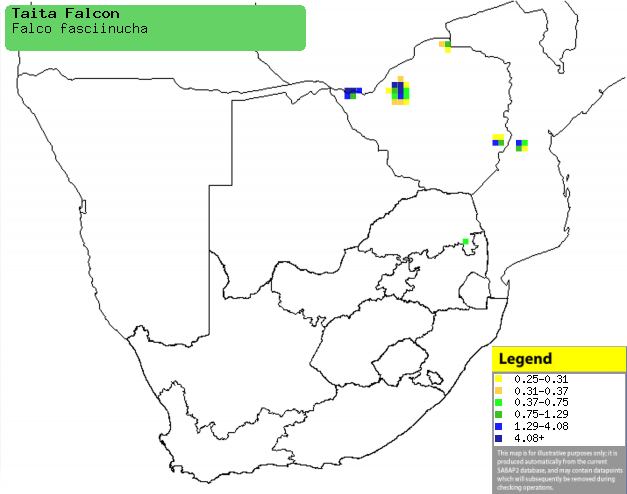|
Falco fasciinucha (Taita falcon)
Taitavalk [Afrikaans]; Taita-valk [Dutch]; Faucon taita
[French]; Kurzschwanzfalke [German]; Falc„o de Taita [Portuguese]
Life
> Eukaryotes >
Opisthokonta
> Metazoa (animals) >
Bilateria >
Deuterostomia > Chordata >
Craniata > Vertebrata (vertebrates) > Gnathostomata (jawed
vertebrates) > Teleostomi (teleost fish) > Osteichthyes (bony fish) > Class:
Sarcopterygii (lobe-finned
fish) > Stegocephalia (terrestrial
vertebrates) > Tetrapoda
(four-legged vertebrates) > Reptiliomorpha > Amniota >
Reptilia (reptiles) >
Romeriida > Diapsida > Archosauromorpha > Archosauria >
Dinosauria
(dinosaurs) > Saurischia > Theropoda (bipedal predatory dinosaurs) >
Coelurosauria > Maniraptora >Aves
(birds) > Order: Falconiformes >
Family: Falconidae
Distribution and habitat
Occurs in a band from Ethiopia through western Kenya to
northern Tanzania, with isolated populations in southern Zambia, Malawi and
southern Africa. Within southern Africa it is rare in patches of Zimbabwe and central Mozambique,
with isolated records from the area around the JG Strydom Tunnel in the Limpopo
Province, South Africa (see photo above). It generally prefers mountainous and
riverine habitats with cliffs, such as dense lowveld bushveld, Mopane (Colosphermum
mopane) and miombo (Brachystegia) woodland on escarpments and
inselbergs.
|
 |
|
Distribution of Taita falcon in southern Africa,
based on statistical smoothing of the records from first SA Bird Atlas
Project (©
Animal Demography unit, University of
Cape Town; smoothing by Birgit Erni and Francesca Little). Colours range
from dark blue (most common) through to yellow (least common).
See here for the latest distribution
from the SABAP2. |
Movements and migrations
Though to be highly sedentary, although it may
move to more open areas in the non-breeding season.
Food
It almost exclusively eats small birds caught aerially,
usually near a cliff. The following food items have been recorded
in its diet:
Breeding
- Monogamous, territorial solitary nester with a long-term pair bond.
- The nest is typically a simple scrape in a depression or sheltered rock
ledge, on a large vertical crag or a less prominent cliff overlooking
woodland or a river valley. It has also been once recorded to use the stick
nest of White-necked raven.
- Egg-laying season is from August-October.
- It lays 3-4 eggs which are mainly incubated by the female for about 34
days.
- The chicks are fed about ten times per day, leaving the nest after about
42 days and sometimes remaining dependent on their parents for at least
another two months.
Threats
Globally Near-threatened, as it has an estimated
population of less than 500 breeding pairs spread across a fragmented
distribution. This status is thought to have been caused by its specialised
habitat requirements, which leave it seriously vulnerable to habitat
loss, such as the clearing of woodland and flooding of rivers.
References
-
Hockey PAR, Dean WRJ and Ryan PG 2005. Roberts
- Birds of southern Africa, VIIth ed. The Trustees of the John Voelcker
Bird Book Fund, Cape Town.
|
